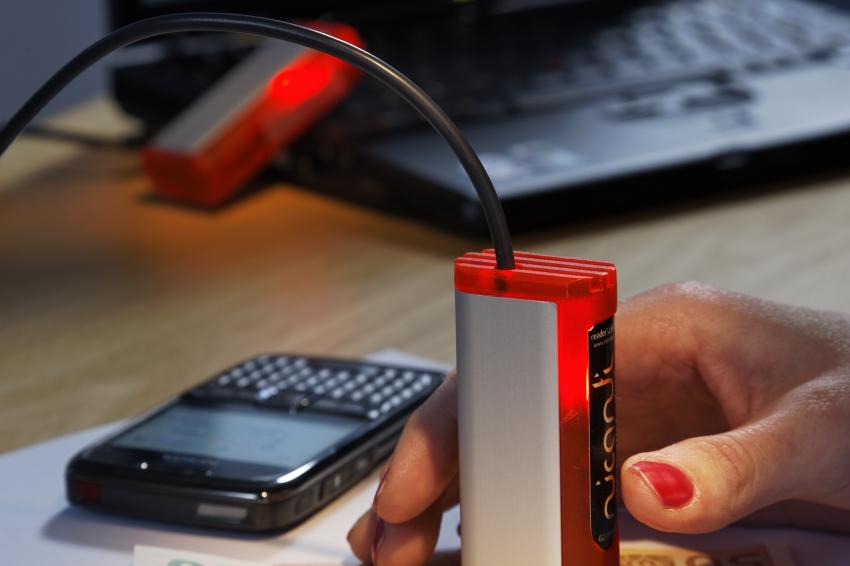Brand Protection – No Chance for Plagiarizers
Organic and Printed Electronics to Counter Product Piracy
Organic and printed electronics offers novel solutions for the brand protection of consumer goods and industrial products. Electrically coded radio tags link back to the legitimate manufacturer to detect falsification at the point of sale. The latest process technologies and applications of organic and printed electronics will be on view at LOPE-C 2010 (Large-area, Organic and Printed Electronics Convention), May 31-June 2 in Frankfurt, Germany.
The elegant sweater boasting a renowned label, the watch of exclusive design, the expensive facial cream - they look genuine. But are they really what they appear to be? Not a cheap imitation, counterfeit, pirated copy? How about being able to check the authenticity of a product at the point of sale? A peek into the R&D labs for organic and printed electronics tells us that exactly this kind of technology is not far away. Researchers have developed tiny radio chips that can be embedded into the product or printed onto the package - all the potential buyer has to do is scan it with a cell phone, which automatically connects back to the manufacturer. If a green light appears, that means all clear for purchase. Red means the customer has almost been duped by a fake.
This is a new solution to age-old problem, and it isn't a moment too soon: The OECD estimated at least $250 billion in damage caused in 2009 by counterfeited material goods. And it's not just consumer goods in global delivery chains that are targeted by pirates - buyers of industrial components and spare parts too must fight falsifications of dubious quality and reliability.
The Solution: Organic and Printed RFID Tags
Radio chips, or radio frequency identification (RFID) printed on thin and flexible foils, are the innovative solution to protect branded products and their packaging containers. That's no easy task: producers and forgers are engaged in a fierce, ever accelerating race to come out as a winner.
Sophisticated high-tech systems are the answer to secure a decisive lead for the legitimate delivery channels.
"Dynamic technologies are needed in order to stay ahead of forgeries," said Wolfgang Mildner, managing director of PolyIC, leading developer of polymer electronics, and chairman of the OE-A. "Standard solutions will rapidly lose their effect."
In the fight against fakes modern printing technology is shaping up as a new force through "functional printing" of tiny micro-electronic systems on organic substrates - thin and flexible plastic foils.
Authenticity Check by Cell Phone
Product identification by standardized optical barcodes read out via laser scanner was established long time ago and can be found in most supermarkets nowadays. But the new, electrically coded radio tags offer a definite plus: their embedded, covered structure. They are detected and evaluated by compact readout devices - even by cell phones equipped with RF capability.
Smart Packaging
The era of product identification through "smart packaging" is upon us. Embedded radio tags enable packages not just to reveal pricing and use-by date. A radio-tag can trace a product or package back to its manufacturer in real time.
"Linking a product with its legitimate manufacturing logistics and delivery chain at the point of sale," Mildner said, "is the topic of RFID technology."
Compared to older ID methods, according to Mildner, authenticity check via printed RFID tags is safer and done automatically: "Electrical coding permits a large variety of proprietary security features. Substituting for optical barcodes will be the killer app of RFID."
Web-Browser Printed on the Package
Packaging is a hotbed of innovation. Take the VTT Technical Research Center of Finland: Their concept of "interactive packaging" involves consumers through web browser-like functions.
"Our know-how enables us to integrate RFID readout devices in cell phones today," said Jani-Mikael Kuusisto, business development manager at VTT. "The initial objective is increased interaction between cell phone and functional surfaces on the package." Embedded radio chips will offer multiple functions selectable via touch control, with links to call up useful consumer information
Has the Package Been Opened Before?
"A bundle of new technologies for printed electronics, including large-area organic light emitting diodes (OLEDs), are being readied in the labs for commercial application, among them automatic proof of opening of a package or container," Kuusisto said. „Unopened, an OLED surface in the package will light up when scanned. Once opened, a warning signal will appear.
"A large problem with falsified products," Kuusisto said, "is fraudulent re-use of opened packages."
Contact
Messe Frankfurt
Taunusstr. 7a
65183 Wiesbaden
Germany
+49 611 95166 18
+49 611 95166 24




